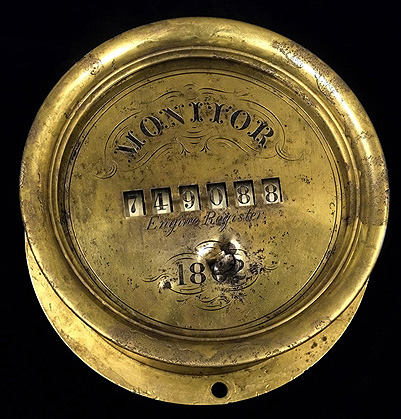The Monitor's Engine and Register
Ship designer John Ericsson designed the Monitor with a distinct purpose in mind: as a venerable warship. The Monitor's unique "vibrating side-lever" engine design allowed the engine to be mounted under water - out of the line of direct enemy fire. The engine, along with its register that tracked the number of hours logged on the engine, were recovered in 2001. Both objects are on display at The Mariners' Museum.
Monitor Engine Recovery

The Monitor's engine was recovered from the National Marine Sanctuary in 2001.
The Monitor's engine was designed by John Ericsson as a "vibrating side-lever engine." He had created similar engines before and decided to use the design again because of its distinctive advantages on a small, low-riding warship.
Most steam engines of the time had pistons that operated in a vertical motion, which occupied a lot of space and made them vulnerable to enemy fire because they were partially above the waterline. In contrast, the Monitor's 30-ton, 400-horsepower engine had pistons that moved horizontally, which reduced the height of the engine and allowed it to be mounted below the waterline.
Artifact Recovery
The engine was recovered from the Monitor's wreck site in 2001. It is now resting upside-down in an alkaline solution to slow corrosion. Over the coming years, conservators will continue to clean and separate the many different pieces of the engine, to properly preserve them. This process will help historians further understand how the engine functioned when it powered the Monitor.
The circular engine register that was mounted to the Monitor's coal-fired steam engine was also recovered in 2001. It was the first, and currently only, artifact recovered from the wreck bearing the vessel's name.
The register faceplate reads "Monitor," written in filigreed Victorian script and arcing under the top curve of the plate. The year that the Monitor was launched, 1862, appears along the bottom of the faceplate. The middle of the disk has six rectangular spaces where numerical digits could be seen. These digits were on small metal discs that would slowly click over to show the engineer how many hours were on the ship's engine.
- Location: The Mariners' Museum, Newport News, Virginia
- Recovery: 2001
- Material: Brass (engine register)
- Notable Features: The Monitor's engine register was the first, and currently only, artifact recovered from the wreck bearing the vessel's name
Related Web Sites:
Monitor National Marine Sanctuary
National Marine Sanctuary Program
The Monitor Center at The Mariners' Museum
Works Consulted:
Monitor National Marine Sanctuary. (1994). A look at the Monitor National Marine Sanctuary: Past, Present and Future.
Monitor National Marine Sanctuary. (2005). Monitor National Marine Sanctuary factsheet.
(top)

 George S. Geer Letters: Life Aboard an Ironclad
George S. Geer Letters: Life Aboard an Ironclad The Monitor's Rotating Gun Turret
The Monitor's Rotating Gun Turret The Monitor's Cannons
The Monitor's Cannons The Monitor's Anchor
The Monitor's Anchor The Monitor's Propeller
The Monitor's Propeller The Red Lantern
The Red Lantern Silverware from the Monitor
Silverware from the Monitor The Monitor's Engine and Register
The Monitor's Engine and Register Condiments and Bottles
Condiments and Bottles Monitor Photomosaics
Monitor Photomosaics